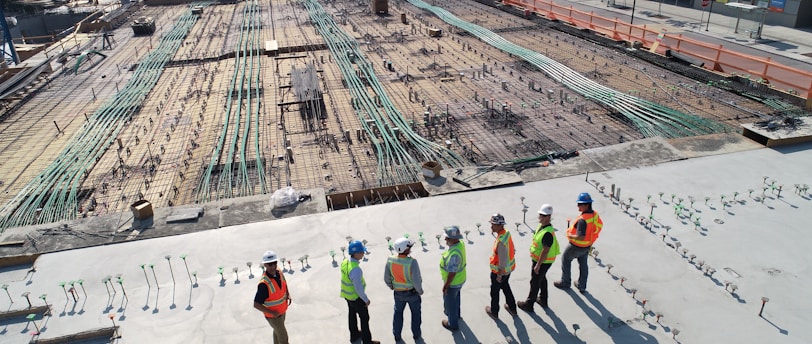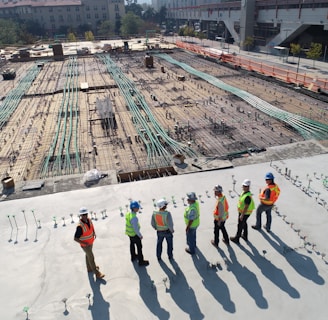Summary of the Construction Safety Manual (CSM) – 5th Edition
The (CSM) Construction Safety Manual by Saudi Aramco is a comprehensive and detailed guide which ensure safety in construction field and oil and gas. It is divided into two volumes...
SAFETY FIRSTSAFETY FIELD FOR LEARNING EARNING


Introduction
The (CSM) Construction Safety Manual by Saudi Aramco is a comprehensive and detailed guide which ensure safety in construction field and oil and gas. It is divided into two volumes:
1. Contractor Safety Administrative Requirements (CSAR)
Volume 1: (CSAR)
1. Purpose and Scope;
- Establishes Saudi Aramco’s safety requirements for contractors.
- Sets minimum safety-related administrative standards.
2. Safety Program and Performance;
- Contractors must develop a safety program aligned with Saudi Aramco’s requirements.
- Regular safety performance monitoring and audits are required.
3. Contractor Prequalification and Site Safety Meetings;
- Contractors must be prequalified based on safety criteria.
- Pre-job safety explanation meetings are mandatory.
4. Safety Personnel and Responsibilities;
- Contractors must employ safety officers based on workforce size.
- Site safety managers and supervisors must be qualified.
5. Hazard Identification and Risk Assessment;
- Contractors must submit a Hazard Identification Plan (HIP) before starting work.
- Work permit system ensures controlled execution all of the hazardous activities.
6. Personal Protective Equipment (PPE) and Safety Training;
- PPE requirements include helmets, gloves, protective eye wear(googles), and flame-resistant clothing (FRC).
- Contractors must provide safety training and refresher courses.
7. Incident Reporting and Emergency Response;
- Incidents must be reported and investigated under following Saudi Aramco guidelines.
- Contractors must have an emergency response plan (ERP) and conduct regular drills.
8. Medical and First Aid Requirements;
- Contractors must provide adequate first aid supplies and medical facilities as mentioned in (MMR).
- Trained first-aid personnel must be available at all the time on work locations.
9. Transportation and Worksite Safety;
- Safe transportation of workers is mandatory, including seat belts and vehicle inspections.
- Worksite housekeeping and layout planning prevent accidents.
10. Compliance and Consequences of Violations;
If there is no compliance it may lead to penalties or contract termination.
Any Contractors must ensure strict compliance to safety policy and regulations.
2. Work Site Safety Manual (WSSM)
Volume 2: (WSSM)
Part I: General Safety
1. Emergency Reporting and Response – Procedures for handling workplace emergencies during any incidents or injury.
2. Incident Reporting and Investigation – Steps for reporting and investigating accidents.
3. Personal Protective Equipment (PPE) – Mandatory PPE requirements and usage on aramco premises where work is going on.
4. Work Permit System – Ensures hazardous tasks are controlled and authorized.
5. Isolation, Lockout, and Hold Tags – Prevents unintended equipment activation.
6. Confined Spaces – Safe entry and egress procedures and atmospheric monitoring of test.
7. Fire Prevention – Fire safety measures, extinguishers, and emergency planning. For both protection and prevention
8. Traffic and Vehicle Safety – Rules for site vehicles and defenceive and pedestrian safety.
9. Compressed Gas Cylinders – Safe handling and storage guidelines with HIP.
10. Hazardous Materials – Identification, labeling, and disposal procedures.
11. Hand and Power Tools – Safe usage of hand tools and maintenance guidelines for power tools.
12. Materials Handling – Safe lifting and storage practices.
13. Heat Stress – Prevention, monitoring, and safety form dehydration.
Part II: Civil Construction Safety:
1. Excavations and Shoring – Protective systems to prevent cave in and collapses.
2. Scaffolding – Erection, inspection, fall protection and fall prevention.
3. Ladders and Stepladders – Safe usage of the ladder and placement.
4. Temporary Walking Surfaces – Control measures to Preventing slips, trips, and falls.
5. Fall Protection – Full-Body Harness requirements and work-at-height safety.
6. Concrete Construction – Safe handling and formwork practices.
7. Steel Erection – Structural stability and rigging safety.
8. Abrasive Blasting – PPE requirements and ventilation measures.
9. Painting and Coating – Safe use of chemicals and fire prevention.
10. Cutting, Welding, and Brazing – Fire safety and ventilation requirements.
11. Roadworks – Traffic control and worker safety.
12. Piling Operations – Foundation safety measures.
13. Explosive Materials – Storage and handling precautions with protection and emergency response plan.
14. Demolition – Safety needs everywhere, so dismantling procedures should follow it.
Part III: Mechanical and Electrical Safety
1. Machine Guarding – Preventing contact with moving parts.
2. Mechanical and Heavy Equipment – Maintenance and safe operation.
3. Electrical Equipment – Lockout/tagout procedures.
4. Pressure Testing – Safe testing of pipelines and vessels.
5. Ionizing Radiation – Radiation safety procedures to follow.
6. Non-Destructive Testing (NDT) – Inspection techniques must apply.
7. Cranes and Lifting Equipment – Safe rigging and load limits.
8. Slings and Rigging Hardware – Inspection and proper usage.
Part IV: Operations Safety
1. Diving Operations – Underwater work safety.
2. Marine Operations – Shipyard and offshore safety.
3. Drilling and Well Servicing – Oil and gas well safety.
4. Aviation Safety – Helicopter operations and emergency landings.
Glossary and References
- Definitions of key safety terms.
- References to Saudi Aramco standards and regulatory guidelines.
Conclusion
The CSM is a difficult document but it should be study by everyone who are working under aramco to ensuring safety compliance. Contractors and workers must adhere to the outlined the basic requirements to maintain a safe work environment.
🔗 Recommended Reads:
full excavation revision for HSEO's
The Hidden Stories of Workers: A Journey of Earning, Learning, and Living Between Lines
The Soil Compactor and the Secret to Success: Lessons from the Ground Up
Summary of the Construction Safety Manual (CSM) – 5th Edition
Unlocking Safety Excellence: A Look Inside the Saudi Aramco Construction Safety Manual CSM (5th Edition)
Mastering Construction Safety: Why the CSM is Your Ultimate Jobsite Guardian
Smart Planning for Earning and Learning: A Path to Growth and Stability
Why the Saudi Aramco Construction Safety Manual Is One of the Most Important Books in the Industry
#safety #hso #hseo #aramco #saudiaramco #csm #safetyofficer

